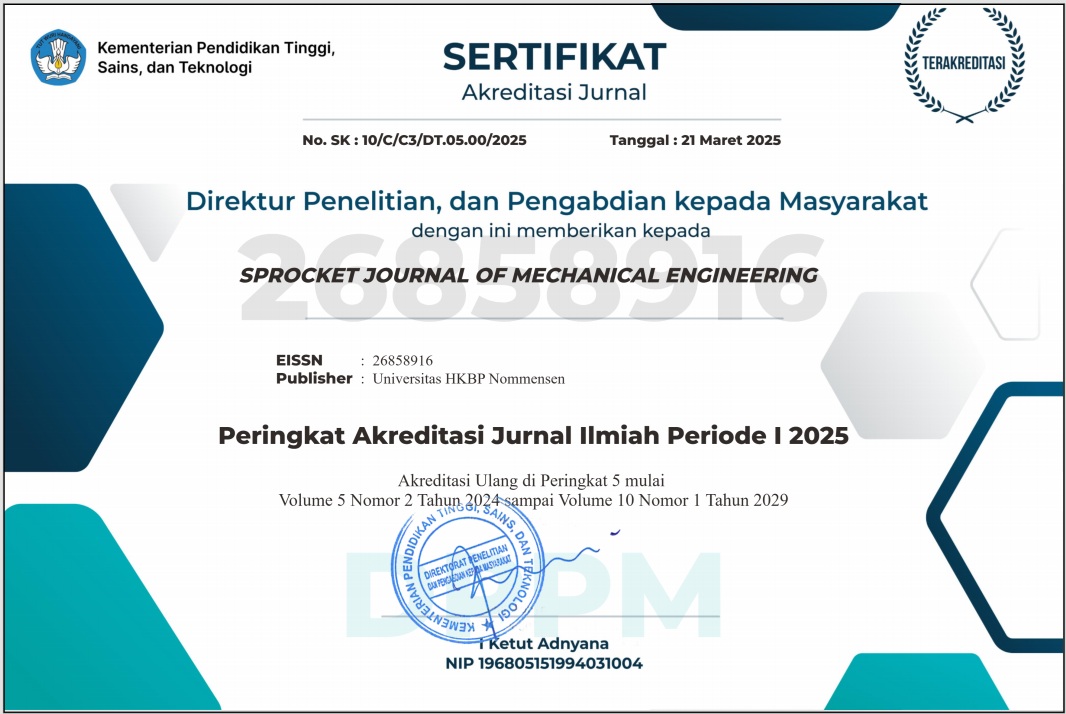Rancangan Fasilitas Pembangkit Listrik Tenaga Sampah: Studi Kasus di Kota Medan Sumatera Utara
Abstract
In planning a power generation system using waste as an energy source, it is necessary to conduct an initial analysis of the potential local waste available. Not all waste can be used as the source of thermal energy by burning in an incinerator. Therefore, the selection is required to obtain the suitable waste and characterization to determine the potential thermal energy content in the waste. This article aims to obtain the electrical capacity produced from local waste to generate electricity in some regions of the city of Medan. The analysis is carried out on the availability of the waste and its potential for thermal energy generated. The selected incinerator of the fixed bed type with a two-stage air supply was explained comprehensively. Minimum pollution, high thermal conversion, and ease of operation are the critical point considered for the selected incinerator. The results revealed that 50 kWe was generated from a power plant system using waste. This amount of electricity can provide electricity for 25 households in the area where the case is located. This study is expected to provide sustainable waste management to the city of Medan in converting the waste into the household electricity supply.
References
[2] F. Rahmawati, “30 Ton Sampah Pasar di Medan Jadi Pupuk dalam 1 Jam, Dijual untuk Pertanian,” Merdeka.com, Medan, 2021.
[3] M. X. Paes, G. A. de Medeiros, S. D. Mancini, A. P. Bortoleto, J. A. Puppim de Oliveira, and L. A. Kulay, “Municipal solid waste management: Integrated analysis of environmental and economic indicators based on life cycle assessment,” J. Clean. Prod., vol. 254, 2020, doi: 10.1016/j.jclepro.2019.119848.
[4] S. Das, S. H. Lee, P. Kumar, K. H. Kim, S. S. Lee, and S. S. Bhattacharya, “Solid waste management: Scope and the challenge of sustainability,” J. Clean. Prod., vol. 228, 2019, doi: 10.1016/j.jclepro.2019.04.323.
[5] C. Hu, X. Liu, and J. Lu, “Robust trading strategies for a waste-to-energy combined heat and power plant in a day-ahead electricity market,” IFAC-PapersOnLine, vol. 52, no. 13, pp. 1108–1113, 2019, doi: https://doi.org/10.1016/j.ifacol.2019.11.344.
[6] F. S. Rogof, Mark J., “WTE Technology and Project Impleentation,” in WTE Technology and Project Impleentation, 2nd ed., 2011, pp. 21–43.
[7] Lubis, “No Title,” 2018, [Online]. Available: https://repositori.usu.ac.id/handle/123456789/9222.
[8] R. A. Dalimunthe, “Studi Karakteristik Sampah Rumah Tangga di Kecamatan Medan Area dan Kecamatan Medan Polonia di Kota Medan (Timbulan, Karakteristik, dan Nilai Kalor),” Universitas Sumatera Utara, 2018.
[9] C. N. Putri, “Studi Karaktersitik Sampah Rumah Tangga di Kecamatan Medan Helvetia dan Kecamatan Medan Selayang di Kota Medan (Timbulan, Komposisi, Karakteristik dan Nilai Kalor),” 2018.
[10] Y. Petriella, “Cadangan Batu Bara Diprediksi Habis 20 Tahun Lagi, Ini Alasannya!,” Bisnis.com, Jakarta, 2020.
[11] Anastasia Arvirianty, “Daftar 12 Daerah Pembangun Pembangkit Listrik Tenaga Sampah,” CNBC Indonesia, Jakarta, 2019.
[12] I. Artharini, “Bisakah kita mengubah sampah jadi energi listrik?,” BBC News Indonesia, 2016.
[13] N. B. Klinghoffer and M. J. Castaldi, Waste to energy conversion technology. Elsevier, 2013.
[14] P. J. Reddy, “Municipal solid waste management,” Netherlands CRC Press., 2011.
[15] E. N. Kalogirou, Waste-to-Energy technologies and global applications. CRC Press, 2017.
[16] H. Krisnani et al., “Perubahan pola pikir masyarakat mengenai sampah melalui pengolahan sampah organik dan non organik di Desa Genteng, Kecamatan Sukasari, Kab. Sumedang,” Pros. Penelit. dan Pengabdi. Kpd. Masy., vol. 4, no. 2, 2017.
[17] D. A. Posmaningsih, “Faktor-faktor yang mempengaruhi partisipasi masyarakat dalam pengelolaan sampah padat di Denpasar Timur,” J. Skala Husada J. Heal., vol. 13, no. 1, 2016.
[18] M. Rahim, “Strategi Pengelolaan Sampah Berkelanjutan,” J. Sipil Sains, vol. 10, no. 1, 2020.
[19] A. S. Suryani, “Peran bank sampah dalam efektivitas pengelolaan sampah (studi kasus bank sampah Malang),” Aspir. J. Masal. Sos., vol. 5, no. 1, pp. 71–84, 2014.
[20] D. Asteria and H. Heruman, “Bank sampah sebagai alternatif strategi pengelolaan sampah berbasis masyarakat di Tasikmalaya (Bank Sampah (Waste Banks) as an alternative of community-based waste management strategy in Tasikmalaya),” J. Mns. dan Lingkung., vol. 23, no. 1, pp. 136–141, 2016.
[21] R. A. Pratama and I. M. Ihsan, “Peluang penguatan bank sampah untuk mengurangi timbulan sampah perkotaan studi kasus: bank sampah Malang,” J. Teknol. Lingkung., vol. 18, no. 1, pp. 112–119, 2017.
[22] B. M. Dwiyanto, “Model peningkatan partisipasi masyarakat dan penguatan sinergi dalam pengelolaan sampah perkotaan,” J. Ekon. Pembang. Kaji. Masal. Ekon. dan Pembang., vol. 12, no. 2, pp. 239–256, 2011.
[23] N. K. A. Artiningsih, “Peran serta masyarakat dalam pengelolaan sampah rumah tangga (Studi kasus di Sampangan dan Jomblang, Kota Semarang).” program Pascasarjana Universitas Diponegoro, 2008.
[24] B. D. Utami, N. S. Indrasti, and A. H. Dharmawan, “Pengelolaan sampah rumahtangga berbasis komunitas: teladan dari dua komunitas di sleman dan jakarta selatan,” Sodality J. Sosiol. Pedesaan, vol. 2, no. 1, 2008.
[25] P. R. Indonesia, “Undang-undang republik indonesia nomor 18 tahun 2008 tentang pengelolaan sampah,” Sekr. Negara, Jakarta, 2008.
[26] J. M. Masjhoer, “Partisipasi Pelaku Usaha Pariwisata dalam Pengelolaan Sampah di Pantai Pulang Sawal, Kabupaten Gunungkidul, Yogyakarta,” J. Pariwisata Terap., vol. 2, no. 2, pp. 122–133, 2018.
[27] A. S. Maulina, “Identifikasi Partisipasi Masyarakat Dalam Pemilahan Sampah di Kecamatan Cimahi Utara Serta Faktor Yang Mempengaruhinya,” J. Perenc. Wil. dan Kota, vol. 23, no. 3, pp. 177–196, 2012.
[28] G. Pratama, “Upaya Modernisasi dan Inovasi Pengelolaan Sampah Berbasis Masyarakat di Desa Leuwimunding Majalengka,” Etos J. Pengabdi. Masy., vol. 2, no. 1, pp. 37–49, 2020.
[29] S. Subekti, I. Prayoga, and A. S. E. Sudrajat, “Pemberdayaan Masyarakat Dalam Pengelolaan Sampah Sebagai Upaya Penanganan Kawasan Kumuh Di Kawasan Pecangaan Kabupaten Jepara,” Indones. J. Spat. Plan., vol. 1, no. 2, pp. 45–50, 2021.
[30] S. A. Mulasari, A. H. Husodo, and N. Muhadjir, “Kebijakan pemerintah dalam pengelolaan sampah domestik,” Kesmas J. Kesehat. Masy. Nas. (National Public Heal. Journal), vol. 8, no. 8, pp. 404–410, 2014.
[31] R. Candrakirana, “Penegakan hukum lingkungan dalam bidang pengelolaan sampah sebagai perwujudan prinsip good environmental governance di kota Surakarta,” Yust. J. Huk., vol. 4, no. 3, pp. 581–601, 2015.
[32] N. H. Setyoadi, “Faktor Pendorong Keberlanjutan Pengelolaan Sampah Rumah Tangga Berbasis Masyarakat Di Kota Balikpapan Dan Bogor,” J. Sains Teknol. Lingkung., vol. 10, no. 1, pp. 51–66, 2018.

This work is licensed under a Creative Commons Attribution 4.0 International License.
Penulis yang menerbitkan dengan SPROCKET JOURNAL OF MECHANICAL ENGINEERING menyetujui ketentuan berikut :
- Penulis memegang hak cipta dan memberikan jurnal hak penerbitan pertama dengan karya yang dilisensikan secara bersamaan di bawah Lisensi Internasional Creative Commons Atribusi 4.0 . yang memungkinkan orang lain untuk berbagi karya tersebut dengan pengakuan atas kepengarangan karya dan penerbitan awal dalam jurnal ini.
- Penulis dapat membuat pengaturan kontraktual tambahan yang terpisah untuk distribusi non-eksklusif atas versi jurnal yang diterbitkan dari suatu karya (misalnya, mempostingnya ke repositori institusional atau menerbitkannya dalam sebuah buku), dengan pengakuan atas penerbitan awalnya di jurnal ini.
- Penulis diizinkan dan didorong untuk mengunggah karya mereka secara daring (misalnya, di repositori institusi atau di situs web mereka) sebelum dan selama proses penyerahan, karena hal ini dapat mengarah pada pertukaran yang produktif, serta kutipan yang lebih awal dan lebih banyak dari karya yang diterbitkan (Lihat Pengaruh Akses Terbuka ).






.png)
.png)

